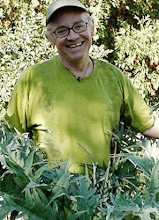 The sweet smell of the V. carlesii
The sweet smell of the V. carlesii The onion seedlings planted out in their rows
The onion seedlings planted out in their rows The onion transplants and lettuce ( parsnips on the far right)
The onion transplants and lettuce ( parsnips on the far right) The onion sets and lettuce
The onion sets and lettuce Making the holes
Making the holes
 Sand in the holes
Sand in the holes Potting soil in the holes
Potting soil in the holes
 Parsnip seed
Parsnip seed The finished parsnips
The finished parsnips The lettuce in between the parsnips
The lettuce in between the parsnips
Planning ahead means that next winter's onions and the parsnips need to be planted now that the Viburnum carlesii is blooming. I have special techniques for each of these plants.
I did have some onions sets, the onions that were too small to eat from last years crop that I stored in the crawl space in my basement, and planted them a few weeks ago for the lettuce video. My other onions were seeded and grown in community flats until planting time. As the pictures show, I plant them thickly in the flats and then plant them in bunches in the garden. This allows me to harvest clumps of onions as a thinning process. As the videos shows, I rinse off the seedlings and plant them in soft ground about 2-3 inches apart. Later I came back and planted some lettuce in the space between the rows. I planted five rows of four onions and one seed shallot - Trailblazer, Derby, Red Marble Cippolini, and Olympus Shallot. I also planted Ailsa Craig exhibition onion. This variety is labeled as very large, so these transplants were planted in between the main rows and I still have a few more to plant out when the main garden gets tilled in the next week. I will harvest green onions from these rows all season long. I like this "water rinse " planting method because it is easy to tease the seedlings apart , they go into the soil with nice roots and seem to keep right on growing even though they have been transplanted.
Parsnips need more work. In my heavy ground I need to do some preparation to get nice big parsnips. I use a old barbell pole and punch cones in the ground. This year I made fourteen holes eighteen inches deep. Into the very bottom I put some play sand I had from last winter and then I filled the hole with potting soil as it holds moisture and is easy for parsnip seed to grow in. I plant the seed, which I buy fresh every year, into the center liberally as shown, and then to mark the parsnips, I plant radish seeds. The parsnips take over 20 days to sprout but the radish are up in 5 so I use them to mark the spots. I will later thin the parsnips to one plant for each space, the radishes will have been harvested by thinning time. I also mark the row with lettuce in the spaces between the parsnips and they will also be harvested before the parsnips get real big and fill the space with their long leaves. The parsnips will stay in this space till harvested in December or later in the winter and spring of 2010. Always planning for the next harvest.
Susan and I were part of two plant sales this year. The combined NEW Master Gardeners/Green Bay Gardeners Club sale and the UWGB tomato and pepper sale. Both events were well attended and we saw many happy people with their plant treasures. I made 85 divisions of perennial plants for one sale and helped with the planting and labeling of many tomatoes and peppers for the other. My peppers and tomatoes are in the cold frames for the next few weeks to acclimatize themselves to the cool nights and bright days waiting for their transplant into the garden. I always have something to do in the garden, seeds to plant, transplants to pot, planning to do so our harvest will continue for as long as possible in the growing season. Planning and planting are part of the fun that is growing a vegetable garden.
Happy Gardening
Onion Seedling Planting

Hi, were you concerned about the crystalline silica in the playsand?
ReplyDelete